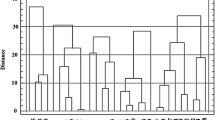Summary
The ‘cutting technique’ or ‘tuberisation stimulus’ (TS) technique was investigated as a method of identifying heat tolerant clones ofSolanum tuberosum ssp.tuberosum.
TS levels were assessed, using leaf cuttings, for 100 experimental clones growing under heat stress in a controlled environment (35/15°C day/night temperatures, 16 h photoperiod). No correlation was found with the tuber yields of these clones when grown in an irrigated trial in Israel.
The relationship between TS levels and tuber production was investigated using early and later maturing cultivars grown with and without heat stress. These experiments showed that the cv. Blanka had high TS levels in all environments and high tuber fresh weights when grown under heat stress. However, the correlation between TS levels and tuber fresh weight for all cultivars was weak (r=0.45).
The results indicated that this TS technique is unlikely to be an accurate method of screeningtuberosum clones for heat tolerance.
Similar content being viewed by others
References
Ben Khedher, M. & E. E. Ewing, 1985. Growth analyses of eleven potato cultivars grown in the greenhouse under long photoperiods with and without heat stress.American Potato Journal 62: 537–554.
Ewing, E. E., 1978. Critical photoperiods for tuberisation: a screening technique with potato cuttings.American Potato Journal 55: 43–52.
Ewing, E. E., 1981. Heat stress and the tuberization stimulus.American Potato Journal 58: 31–49.
Ewing, E. E. & P. F. Wareing, 1978. Shoot, stolon, and tuber formation on potato (Solanum tuberosum L.) cuttings in response to photoperiod.Plant Physiology 61: 348–353.
Ewing, E. E., B. A. Kahn, M. B. Lazin, M. Ben Khedher, H. A. Mendoza & R. L. Plaisted, 1983. Selecting for heat tolerance within populations derived from the Cornell Andigena collection. Proceedings of the International Congress on ‘Research for the Potato in the Year 2000’. Lima, Peru, 22–27 February 1982, p. 81–82.
Keller, E. R. & S. Berces, 1966. Check-testing for virus Y and leaf-roll in seed potatoes with particular reference to methods of increasing precision with the A6-leaf test for virus Y.European Potato Journal 9: 1–14.
Levy, D., 1983. CultivatedSolanum tuberosum L. as a source for the selection of cultivars adapted to hot climates.Tropical Agriculture 61: 167–170.
Mendoza, H. A., 1976. Adaptation of cultivated potatoes to the lowland tropics. Proceedings of the Fourth Symposium of the International Society for Tropical Root Crops, p. 50–53.
Mendoza, H. A. & R. N. Estrada, 1979. Breeding potatoes for tolerance to stress: heat and frost. In: H. Mussel & R. C. Staples (Eds), Stress physiology in crop plants, p. 228–262. Wiley Interscience, New York.
Rasco, E. T., R. L. Plaisted & E. E. Ewing, 1980. Photoperiod response and earliness ofS. tuberosum ssp.andigena after six cycles of recurrent selection for adaptation to long days.American Potato Journal 57: 435–447.
Sipos, J. & R. K. Prange, 1986. Response of ten potato cultivars to temperature as measured by chlorophyll fluorescence in vivo.American Potato Journal 63: 683–694.
Author information
Authors and Affiliations
Rights and permissions
About this article
Cite this article
Harvey, B.M.R., Lee, H.C. & Susnoschi, M. Assessment of heat tolerance in potato (Solanum tuberosum ssp.tuberosum) under controlled environmental conditions: the ‘cutting technique’. Potato Res 31, 659–666 (1988). https://doi.org/10.1007/BF02361859
Accepted:
Issue Date:
DOI: https://doi.org/10.1007/BF02361859




